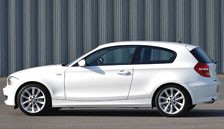If asked to name the most popular models (the heartland cars in the industry jargon) of the three German premium brands, most people would regard it as a pretty easy question.
For BMW, they would say the 3 Series, for Audi the A4, and for Mercedes there might be a bit of a pause before they (probably) plumped for the E-Class, which has a longer lineage than most royal families.
However, the heartland is shifting. Audi’s most popular car is now the A3, which overtook the A4 last year and now outsells it by 50%.
Even the BMW 3 Series is no longer the sure thing it once was. In 2007, it outsold the 1 Series by a factor of 2.5:1, but now it is only the ratio is 1.3:1 – so its lead over the 1 Series has halved in three years.
Given that the 1 Series is an older design with controversial styling and barely enough room to stow a cat, that is a remarkable development.
Only Mercedes continues to have a clear bias towards larger cars, with the C-Class and E-Class being almost neck-and-neck as Mercedes’ top seller.
However, that fact might say more about the uncompetitive A- and B-Class models than about the strength of larger cars.
If the current trend continues, both Audi and BMW will have their biggest sellers in the lower medium segment in a couple of years (especially as the 1 Series and A3 are due to be refreshed before their larger siblings).
That does raise interesting questions about the relationship between size and prestige.
Both the A3 and 1 Series have done well over the years as being like their big brothers, only smaller. Clearly that halo effect is a huge bonus when making a smaller car – “You never thought you could afford a new 3 Series, so here is a 1 Series” is a compelling message.
However, while perception always lags reality, it does eventually catch up. If the perception in a few years is that the A4 is like an A3 but bigger, that is less compelling.
Of course, the three German brands will say that, with downsizing, prestige will be largely independent of size, but is that completely true? The fact is that the most popular A3 is the 105 bhp diesel and the most popular 1 Series is the 116i – both cars with a list price of under £20K before options. A sub-£20K hatchback is hardly an aspirational car to most people, whereas the most popular versions of their big brothers are the 320d and A4 TDI 140 – cars that the majority of people would see as something to aspire to.
Prestige brands have proved they can make smaller cars without damaging their brand, but is that because the smaller cars were always smaller sellers? Does prestige have
as much to do with sales mix as with size?














Login to comment
Comments
No comments have been made yet.